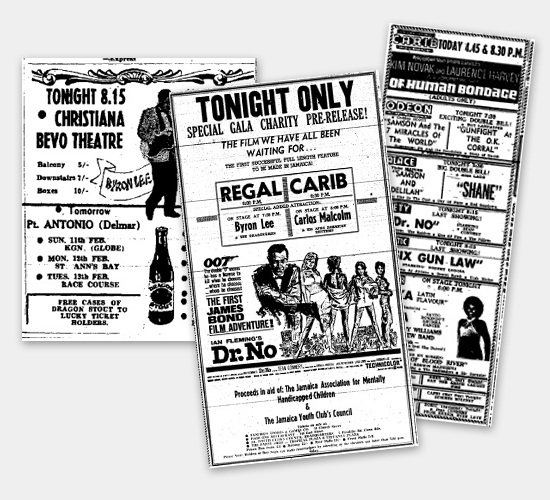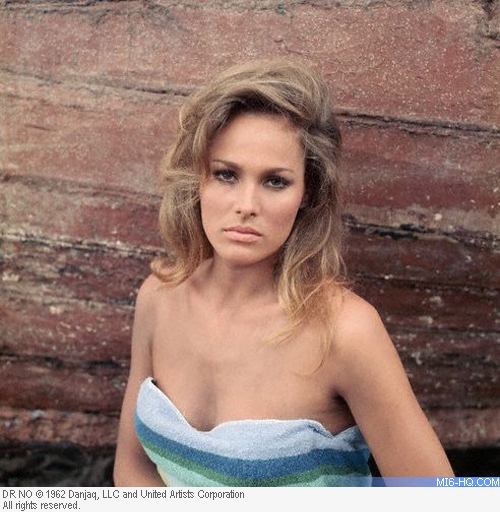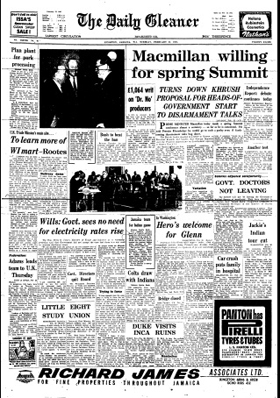 |
| |
MI6 guest writer Edward Biddulph looks at the shooting of the first Bond adventure, as seen through the eyes of the Jamaican Gleaner...
|
|
Bond At 50: Dr. No in the Gleaner
26th April 2012
The arrival of Eon Productions and a host of international stars in Jamaica in January 1962 generated a huge amount of excitement in the country. And throughout the five or six weeks that the film crew spent in Jamaica to film the first Bond film, "Dr. No", the Daily Gleaner, Jamaica's famous newspaper, regularly reported on progress.
The Gleaner was already part of James Bond's world. In the novels, it was Bond's newspaper of choice when he was in the country, and the newspaper had a cameo role in "Dr. No" (1957) when a photographer from the Gleaner attempts to snap Bond when he enters the arrivals hall of the Palisadoes Airport in Kingston, a plot detail that would be repeated in the film.
A trawl through the pages of the Gleaner suggests that Bond's public arrival in Jamaica in "Dr. No" reflected Ian Fleming's experiences. In the edition of January 13, 1948, the Gleaner announced that Fleming and Lady Ann Rothermere had arrived the day before. A photograph of the couple accompanied the piece. If Fleming had hoped for a low-key arrival, considering the delicate nature of his relationship with the still married Ann, he was to be disappointed. Bond's visit to King's House, the residence of the governor of Jamaica, also had the ring of authenticity. Gleaner readers learned on February 12, 1948, that Fleming and Ann Rothermere had been lunch guests of the governor at King's House.

Above (left to right): An advert for Byron Lee and the Dragonaires who contributed to the sound of "Dr. No"; the charity premire announcement for "Dr. No"; evidence 007 is still going strong in Jamaica with film listings from 1964.
|
Given the strong associations between the Gleaner and Fleming and Bond, it is little wonder that the paper would show such interest in the filming of "Dr. No".
The edition dated January 16, 1962, revealed that the "Dr. No" team arrived in Jamaica on Sunday, January 14. Albert Broccoli was reported as saying that the crew would be in Jamaica for about five or six weeks, and that they would be filming all over the island. What is more, the film would be a top feature. Sean Connery had already been in the island for about a week. Director Terence Young was to view local musicians at the Copacabana Club on the Wednesday evening (17th) for the cabaret scenes in Pussfeller's bar. (The scenes would be filmed at Morgan's Harbour, a hotel and yacht club on the Palisadoes Main Road, and the music - the infectious piece, 'Jump Up' - performed by Byron Lee and the Dragonaires.)
The cameras started rolling on Tuesday, January 16. The following day, the Gleaner reported that the first scenes to be shot were Bond's arrival at the Palisadoes airport and the attempt by the Gleaner's freelance photographer to take a picture of Bond. The photographer, the Gleaner reminded readers, was played by Marguerite LeWars, Miss Jamaica in 1961, and was one of a number of roles that had gone to Jamaican actors.
There was more excitement when Ursula Andress flew into Kingston on January 29, and her arrival was reported in the Gleaner two days later. The piece noted that she was to play the role of Honey, an island girl who meets Bond in the course of his adventure, and added that Andress was staying at the Courtleigh Manor Hotel in Kingston along with rest of the cast.

Above Ursula Andress in a publicity photograph, taken in Jamaica, for "Dr. No"
|
Production moved to the north coast for filming the following week. A Gleaner correspondent recorded the details in a small piece published on February 7. The film crew arrived in St Ann's Bay in the Ocho Rios area the previous day and was due to shoot on the waterfront. Other scenes were planned to be filmed on Laughing Water beach and on Love Island, two miles west of St Ann's Bay. The filming at Laughing Water was to produce probably the most iconic scene in the Bond series - the moment Ursula Andress as the bikini-clad Honey Ryder emerges from the sea.
Not all news provided good publicity. On February 8, the Gleaner reported that about 100 people had gathered at Eon Productions' office in Carib Ocho Rios Sea and Country Club seeking work on the production. Most would be disappointed, as production manager J Rudkin told the crowd that only five men were sought. Another 35 jobs had gone to Kingstonians. The crowd angrily demanded that no filming take place until more work was offered, but Ocho Rios councillor Sydney James told the crowd to 'take it easy', and managed to secure a promise from J Rudkin that he would try to employ as many people as he could or rotate the workers.
Then, on February 27, the Gleaner revealed that a writ on behalf of musicians Carlos Malcolm and Ernest Ranglin had been served on Eon Productions by the musicians' representative, Hugh Levy Jr. Levy claimed that Malcolm had been engaged to compose music for the film and supervise the recordings, while Ranglin was employed to look after the arrangements. Levy was seeking to recover £1,064.
Right: Front page of the Gleaner on February 27, 1962. |
|

|
Filming in Jamaica wrapped on February 21, 1962, but Jamaicans had to wait until 1963 to see "Dr. No". An article in the Gleaner dated January 28, 1963, reported on a cocktail party given by Douglas Graham, managing director of the Palace Amusement Company, for Meyer Hutner, United Artists' publicity manager, who had announced earlier that the Jamaican première of the film would take place in April or May that year.
In the event, Jamaica received its première on September 17, 1963, at both the Regal and Carib cinemas. The Gleaner ran an article publicising the event, and took the opportunity to extol the benefits to film companies of filming in the country. Over a year later, cinemas in Kingston were still showing "Dr. No". The Sunday Gleaner of November 1, 1964, also recognised what Time magazine would call 'Bondomania', noting that the success of James Bond had spawned a rash of imitators, among them Columbia's "Code 7 - Victim 5", and "Our Man Flint" by 20th Century Fox.
Many thanks to Edward Biddulph.
About the Author
Edward Biddulph is the author of "Licence to Cook: recipes inspired by Ian Fleming's James Bond", and writes 'James Bond memes' (http://jamesbondmemes.blogspot.co.uk/), a blog exploring the ideas and influences behind James Bond.